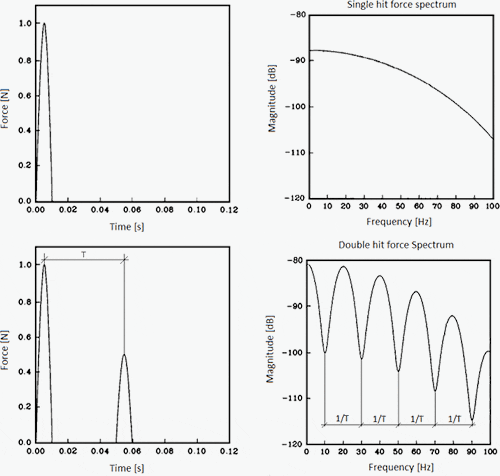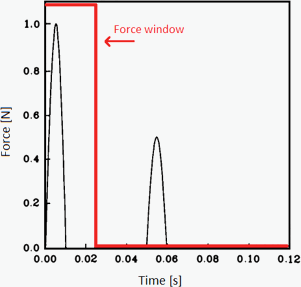Question
Why could modal hammer double impacts have a negative influence on modal analysis results?
Answer
With modal hammer double impacts, the second pulse affects the periodicity of the mechanical excitation. The excitation is not a clear transient pulse after the second impact and therefore the spectrum of the force pulse is not smooth. The second impact and its delay, with respect to the original hit, cause some frequencies to be excited differently from the others. Please refer to Figure 1 below, which shows the difference in the spectral representations between single and double hits.

Figure 1
As the right lower graph shows, excitation magnitude differences could reach 30dB at some frequencies, resulting in an amplitude of excitation 31 times lower than at the adjacent frequencies. [1]
The delay between the first and second hit determines which frequencies are excited less than others. As a result of insufficient excitation at some frequencies, not all vibration modes may be excited or signal-to-noise-ratio related problems may occur. Additionally, the delay between the pulses is a difficult parameter to control; the spectrum of excited vibrations may vary from one modal test to another. Because of this, the final result, which averages several tests, may not correctly represent a specimen's properties.

Figure 2
Application of a force window could hide the presence of the second hit for purposes of signal analysis, but this would only serve to mask its true influence on the dynamic output signal of the specimen. [2]

Figure 3
Demonstrating the differences between results (obtained transfer functions) of single and double impact tests. The "bumpy" shape indicates a modal hammer double impact.
References
1. Eberhard Sengpiel's online calculator; http://www.sengpielaudio.com/Calculations03.htm
2. Dave Brown, Structural Dynamics Research Lab, University of Cincinnati, "Weaknesses of Impact Testing"